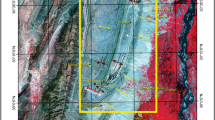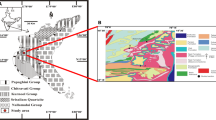Abstract
Hazara Basin lies within lesser Himalayan region and has undergone complex depositional and tectonic episodes responsible for accumulation of different economic minerals. Phosphate, ironstone, manganese, coal and china clay deposits reported from the area indicate different sedimentary environments including deep marine to carbonate and clastic shallow marine, glaciogenic and fluvial systems. These variable environments were mainly a result of different tectonic events, which were caused by formation and rifting of Rodina, Gondwana, Pangaea, India, Madagascar and collision of India with Eurasia. Phosphate was formed in anoxic shallow marine environments during Cambrian in Sirban Member and Hazira Formation, whereas, ironstone deposits were formed in oxygenated shelf and/or residual mechanisms during nondepositional periods, e.g., at the base of Jurassic and Tertiary successions. China clay was also formed at unconformable surface at the base of Shinwari Formation of Jurassic age. Coal within Chichali Formation was formed in anoxic, organic-rich deltaic shelf conditions. Basin evolution combined with stratigraphic set up of the region has played very important role in formation and exploration of these economic mineral deposits.










Similar content being viewed by others
References
Ahmad I, Khan SD, Lapen T, Burke K, Jehan N (2013) Isotopic ages for alkaline igneous rocks, including a 26 Ma ignimbrite, from the Peshawar plain of northern Pakistan and their tectonic implications. J Asian Earth Sci 62:414–424
Ahsan N (2008) Facies Modeling, Depositional and Diagenetic Environments of Kawagarh Formation Hazara Basin Pakistan. Unpublished Ph.D thesis. Punjab University Lahore Pakistan 235p
Ahsan N, Chaudhry MN (2008) Geology of Hettangian to Middle Eocene rock of Hazara and Kashmir basin of northwest lesser Himalayas, Pakistan. Geol Bull Punjab Univ 43:131–152
Ainardi R, Champetier Y (1976) Processus de formation d’intraclastes par dessication en milieu margino-littoral; exemple dans le «Purbeckien» du Jura. Bull Soc Géol France 718(1):159–164
Asif AU, Afzal M, Rehman U, Hussain S (2012) Microfacies analysis and Depositional Environments of Kawagarh Formation Dungagali Abbottabad, Pakistan. Unpublished BS thesis COMSATS Institute of Information Technology Abbottabad 60p
As-Saruri MA, Sorkhabi R, Baraba R (2010) Sedimentary basins of Yemen: their tectonic development and lithostratigraphic cover. Arab J Geosci 3:515–527
Baig MS (1991) Chronology of pre-Himalayan and Himalayan tectonic events, northwest Himalaya, Pakistan. Kashmir J Geol 8–9:197
Baig MS, Lawrence RD (1987) Precambrian to Early Paleozoic Orogenesis in the Himalaya. Kashmir J Geol 5:1–21
Baksi AK, Barman TR, Paul DK, Farrar E (1987) Widespread Early Cretaceous flood basalt volcanism in eastern India: geochemical data from the Bengal Rajmahal Sylhet Traps. Chem Geol 63:133–141
Bouma AH (1962) Sedimentology of some Flysch deposits: a graphic approach to facies interpretation. Elsevier, Amsterdam, 168 p
Butt AA (1972) Problems of strarigraphic nomenclature in the Hazara district NWFP Pakistan. Geol Bull Punjab Univ 9:65–69
Calkins JA, Offield TW, Abdullah SKM, Ali ST (1975) Geology of the southern Himalaya in Hazara Pakistan and adjacent areas. U. S Geological Survey Professional Paper 716-C: 1–29
Crawford AR, Davis RG (1975) Ages of the pre-Mesozoic formations of the lesser Himalaya Hazara District, North Pakistan. Geol Mag 112:509–514
Danilchik W (1961) The iron formation of the Surghar and western Salt Range, Mianwali District, West Pakistan. U. S Geological Survey Professional Paper 424-D: 228–231
Davies LM (1930) The fossil fauna of the Samana Range and some neighbouring areas; part I. An introductory note. Mem Geol Surv India Palaeontol Ind New Ser 15:1–15
Davies LM, Pinfold ES (1937) The Eocene beds of the Punjab salt range. Mem Geol Surv India Palaeontol Ind New Ser 24:1–79
DiPietro JA, Pouge K (2004) Tectonostratigraphic subdivisions of the Himalaya: a view from the west. Tectonics 23, TC5001. doi:10.1029/2003TC001554
Duppret L, Dissler E, Dore F, Gresselin F, Gall JE (1990) Cadomian geodynamic evolution of the northeastern Armorican Massif In: D’Lemos RS et al (eds) The Cadomian Orogeny. Geological Society of London 115–131
Fatmi AN (1972) Lithostratigraphic units of Kohat-Potwar region: Report of the Stratigraphic Committee of Pakistan with an introductory note by Fatmi AN Secretary. Geological Survey of Pakistan Information Release No. 46
Fatmi AN (1973) Lithostratigraphic units of the Kohat-Potwar Province Indus Basin, Pakistan (Rept Strati Comm Pakistan). Mem Geol Surv Pakistan 10:1–80
Fatmi AN (1977) Mesozoic. In: Ibrahim Shah SM (ed) Stratigraphy of Pakistan. Geological Survey of Pakistan Memoir 12:29–56
Feistmantel O (1882) Note on remains of palm leaves from the (Tertiary) Murree and Kasauli beds in India. India Geological Survey Records 15:51–53
Gardezi AH, Ghazanfar M (1965) A change of facies at the base of the Jurassic in District Hazara, West Pakistan. Geol Bull Punjab Univ 5:53–56
Garzanti E (1993) Himalayan ironstones “superplumes” and the breakup of Gondwana. Geology 21:105–108
Hallam A, Maynard JB (1987) The iron ores and associated sediments of the Chichali formation (Oxfordian to Valanginian) of the Trans-Indus Salt Range, Pakistan. J Geol Soc Lond 144:107–114
Hottinger L (1974) Alveoloinids Cretaceous-Tertiary Larger Forams. Esso Prod Res Europ Lab EPR-E-4 SP: 74:1–84
Katz MB (1979) India and Madagascar in Gondwanaland based on matching Precambrian lineaments. Nature 279:312–315
Kazmi AH, Abbassi IA (2008) Stratigraphy and historical geology of Pakistan. Department & NCE in Geology, University of Peshawar, 524p
Kazmi AH, Jan MQ (1997) Geology and tectonics of Pakistan. Graphic Publishers, Karachi, 554p
Latif MA (1970) Explanatory notes on the geology of the southeastern Hazara to accompany the revised geological map. Jahrb Geol Bundesanst 15:25–61
Latif MA (1976) Stratigraphy and micropaleontology of the Galis group of Hazara to accompany the revised geological map-Jahrab. Geol Bull Punjab Univ 13:1–63
Latif MA, Yasin AR, Shafique NA, Ashraf M (1995) Late mesozoic sedimentary megacycle in the rifted Haro Trough, Hazara, Pakistan and its hydrocarbon implications in the Northern Rim of the North West Himalayan Basin. J Hydrocarb Res 7–1:31–52
Le Fort P, Debon F, Sonet J (1980) The lesser Himalayan cordierite granite belt topology and age of the pluton of Maneshra Pakistan. Geol Bull Univ Peshawar 13:51–61
Marks P, Ali CM (1962) The Abbottabad formation: a new name for the Middlemiss, Infra-Triassic deol. Geol Bull Punjab Univ 2:65
Munir HM, Baig MS (2005–2006) Upper Cretaceous of Hazara and paleogene biostratigraphy of Azad Kashmir north west Himalayas Pakistan. Geol Bull Punjab Univ 40–41:69–87
Naka T, Warraich MY, Hirayama J, Hassan S (1996) Stratigraphy and structure of the Precambrian to Mesozoic, especially Mesozoic (?) to lower Cambrian phosphate bearing formations, in Abbottabad, Pakistan. Bull Geol Surv Jpn 47(11):549–575
Nichols G (2009) Sedimentology and stratigraphy, 2nd edn. Wiley, Blackwell, 432p
Paracha W (2004) Kohat plateau with reference to Himalayan tectonic general study. CSEG recorder 46–52p
Pascoe EH (1959) Manual of geology India and Burma, vol. II. India Govt Press, Calcutta, pp 484–1338
Pivnik DA (1998) Magnetostratigraphy and sedimentology of the hazara intermontane basin, Pakistan. Geol Bull Univ Peshawar 21:85–104
Pogue KR, Hylland MD, Yeats RS, Khattak WU, Hussain A (1999) Stratigraphic and structural framework of Himalayan foothills, northern Pakistan. In: Macfarlane A, Sorkhabi RB, Quade J (eds) Himalaya and Tibet: mountain roots to mountain tops. Geological Society of America Special Paper 328: 257–274
Roy S (1992) Environments and processes of manganese deposition. Econ Geol 87:1218–1236
Rushton AWA (1973) Cambrian fossils from the Hazara Shale Pakistan. Nature 243:130–142
Sameeni SJ, Nazir N, Karm AA, Naz H (2009) Foraminiferal biostratigraphy and reconnaissance microfacies of paleocene Lockhart Limestone of Jabri area Hazara northern Pakistan. Geol Bull Punjab Univ 44:86–95
Searle MP, Khan MA (1996) Geological map of North Pakistan and adjacent areas of Northern Ladakh and Western Tibet, scale 1:650,000. Oxford University, Oxford
Seeber L, Armbruster JG, Quittmeyer RC (1981) Seismicity and continental subduction in the Himalayan arc. In: Gupta HK, Delany F (eds) Zagros-Hindukush-Himalaya Geodynamic Evolution. Amer Geophys Union Geodynamics Series 3: 215–242
Sengor AMC, Altiner D, Cin A, Ustaomer T, Hsu KJ (1988) Origin and assembly of the Tethyside orogenic collage at the expense of Gondwanaland. In: Audley-Charles MG, Hallam A (eds) Gondwana and Tethys. Geological Society of London Special Publications 37:81–119
Shah SMI (1977) Stratigraphy of Pakistan. Pak Geol Surv Mem 12:138
Shah MT, Moon CJ (2004) Mineralogy, geochemistry and genesis of the ferromanganese ores from Hazara area NW Himalayas northern Pakistan. J Asian Earth Sci 23:1–15
Silva PI, Bolli HM (1973) Late Cretaceous to Eocene Planktonic foraminifera and stratigraphy of Leg 15 sites in the Caribbean Sea. In: Edgar NT, Saunders JB et al (eds) Initial reports of the deep sea drilling project 15. US Government Printing Press, Washington, DC, pp 449–547
Tahirkheli RAK (1982) Geology of the Himalayas Karakoram and Hindukush in Pakistan. Geol Bull Univ Peshawar 15:1–15
Tahirkheli RAK, Jan MQ (1979) A preliminary geological map of Kohistan and the adjoining areas North Pakistan. Geological Bulletin University of Peshawar 11
Umar M, Khan AS, Kelling G, Kassi AM (2011a) Depositional environments of Campanian–Maastrichtian successions in the Kirthar Fold Belt Southwest Pakistan: tectonic influences on Late Cretaceous sedimentation across the Indian Passive Margin. Sediment Geol 237:30–45
Umar M, Friis H, Khan AS, Kassi AM, Kasi AK (2011b) The effects of diagenesis on the reservoir characters in sandstones of the Late Cretaceous Pab Formation, Kirthar Fold Belt, southern Pakistan. J Asian Earth Sci 40:622–635
Umar M, Friis H, Khan AS, Kelling G, Kassi AM, Sabir MA, Farooq M (2013) Sediment composition and provenance of the Pab Formation, Kirthar Fold Belt, Pakistan: signatures of hot spot volcanism, source area weathering, and paleogeography on the western passive margin of the Indian plate during the Late Cretaceous. Arab J Sci Eng. doi:10.1007/s13369-013-0850-4
Van der Voo R, Spakman W, Bijwaard H (1999) Tethyan subducted slabs under India. Earth Planet Sci Lett 171:7–20
Vildaya KS (1995) Proterozoic sedimentation and Pan-African geodynamic development in the Himalaya. Precambrian Res 74:35–55
Yoshida M, Khan IH, Ahmad MN (1998) Remanent magnetization of oolitic ironstone beds Hazara area Lesser Himalayan thrust zone, Northern Pakistan: its acquisition, timing, and paleoenvironmental implications. Earth Planet Space 50:733–744
Zahid M, Ahmad S, Rehman G, Ali F (2009) Structural geometry of a part of the southeastern Hazara Fold-Thrust Belt Khyber Pakhtunkhwa Pakistan. Pak J Hydrocarb Res 19:19–28
Author information
Authors and Affiliations
Corresponding author
Rights and permissions
About this article
Cite this article
Umar, M., Sabir, M.A., Farooq, M. et al. Stratigraphic and sedimentological attributes in Hazara Basin Lesser Himalaya, North Pakistan: their role in deciphering minerals potential. Arab J Geosci 8, 1653–1667 (2015). https://doi.org/10.1007/s12517-014-1322-1
Received:
Accepted:
Published:
Issue Date:
DOI: https://doi.org/10.1007/s12517-014-1322-1




